This project is made possible through the partnership of WATER CHARITY and the NATIONAL PEACE CORPS ASSOCIATION. ![]()
This project has been completed. To read about the conclusion, please scroll down.
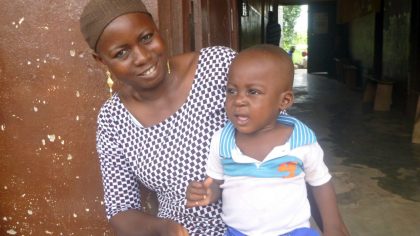 Location
Location
Sabaringade, Central Region, Togo, West Africa
Community Description
The village of Sabaringade is located roughly between Sokode, the capital of the Centrale Region, and the town of Tchamba, west of the Benin border. Similar to other villages in this region, the population is primarily Muslim and of Kotikoli, Lamba, Kabyé, and Fulani ethnic make-up.
The village population of 2,000 inhabitants is governed by two different chiefs as a result of a territorial dispute some years back, with the main road serving as the dividing line. However, both chiefs and their respective communities collaborate on community projects where participation is required.
The main livelihood is the cultivation of maize, manioc, yams and tomatoes. The community is food secure most years, particularly in the staple grains. There is no large-scale livestock production except that offered by the nomadic Fulani herders, though most households augment their diet and income with some animal husbandry of chickens and other fowl, sheep albeit on a small-scale.
Sabaringade experiences water shortages during the dry season, and depending on the strength of the prior rainy season, depletion of well water can begin as early as January and will last until the onset of rains the following June. There are several shallow, open wells in both individual households and in communal locations however for a more permanent water source, the needs are satisfied by two deep boreholes well, though only one well, constructed in 2017 by a Muslim NGO, appears to function well.
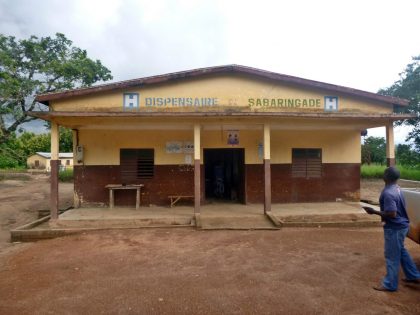 The health clinic at Sabaringade was constructed in 2006 by an international NGO and serves a population of 3,800 people which includes neighboring villages. The clinic is a standard 6-room cement block structure, equipped with indoor plumbing, faucets and drains, and due to its proximity to the main east-west road, has electric power. The staff consists of a head nurse, a midwife, a pharmacist. Births average 5 a month suggesting many women continue to give birth at home. The clinic as in other areas holds trainings in family planning and birth control, STD’s, HIV prevention and maternal-childhood nutrition.
The health clinic at Sabaringade was constructed in 2006 by an international NGO and serves a population of 3,800 people which includes neighboring villages. The clinic is a standard 6-room cement block structure, equipped with indoor plumbing, faucets and drains, and due to its proximity to the main east-west road, has electric power. The staff consists of a head nurse, a midwife, a pharmacist. Births average 5 a month suggesting many women continue to give birth at home. The clinic as in other areas holds trainings in family planning and birth control, STD’s, HIV prevention and maternal-childhood nutrition.
Problem Addressed
The water source at the Sabaringade clinic is a 10-meter well equipped with a hand pump, a metal water tower, and polyethylene tank. This shallow well produces water of very poor quality due to both leaky, rusty pipes leading from the water tower to the intake at the clinic, and to the generally poor quality of water common in shallow wells which tap a transient source often contaminated in this region a heavy use of by agricultural chemicals.
The well typically runs dry by January. Currently the system is mostly nonfunctional and when working provides just enough water for general cleaning. Given the depth of water in the well particularly during the onset of the dry season, the time required to manually pump water to the 4.5 m water tank is prohibitive for the staff and often is of insufficient quantity.
The lack of water at the clinic is particularly onerous for women giving birth. The relatives of patients are required to haul water during and post-birth for cleaning of the maternity room, utensils and birthing cloth. Potable water for staff and patients is brought to the clinic from a borehole well 5km away in plastic containers and treated with bleach.
Project Description
This project is to build a borehole well for the clinic. Under the guidance of the Department of Hydraulics and Sanitation’s regional office in Sokode and with support from the Ministry of Health regional director, who identified clinics with the most critical need, and a local drilling company, this project proposes to drill a 60- to 100-meter borehole well at the clinic, equipped with the following:
• An electric submersible pump,
• a 4-meter high cement block water tower,
• a polyethylene tank, 2,000 liters in volume, and
• indoor plumbing (water basin and faucet) to the one room with a subsurface drain.
The submersible pump will be run using a gas-powered generator as there is currently no electric power in the community. The local drilling company selected, Plomberie Génerale de Réalisation de Forage, in operation since 1998 and based in Tchamba, has extensive experience drilling deep borehole wells throughout Togo and regionally in Burkina Faso, Benin and Nigeria.
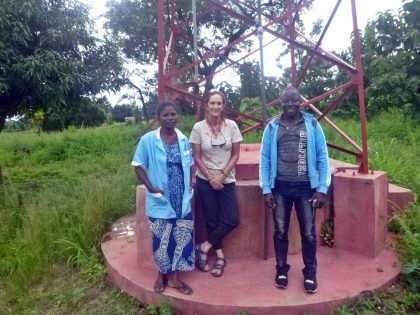 Project Impact
Project Impact
3,800 people will benefit from this project.
Project Administration
This project will be managed by Anne Jeton, hydrologist and Returned Peace Corps Volunteer (RPCV), Burkina Faso (’82-’85) and Returned Peace Corps Response Volunteer (RPCRV), Togo (’16 -’17).
Anne was sent to Togo on behalf of Water Charity to develop and administer new projects, and to coordinate with Peace Corps.
Monitoring and Maintenance
Along with staff from the Department of Hydraulics and Sanitation who will monitor the well “indefinitely” (the well data becomes part of the official borehole well database, and as such is included in periodic field monitoring by technicians based in each Prefecture), the contract for well drilling states a one-year guarantee provided by the drilling company. Problems with pump and borehole functioning are typically resolved in the first month of use.
Proper screening of the borehole and submersible pump placement relative to the static water table often mitigates the most common problems. However, any mechanical problems surfacing in the first year will be the responsibility of the drilling company.
The clinic staff will be responsible for maintaining a well repair account which will be funded from the sale of medicines. The clinic will decide a nominal fee for water use should the water account be insufficient, or the community will be asked to contribute directly to the costs.
Project Funding
This project has been funded by an anonymous donor.
Conclusion of Sabaringade Clinic Borehole System Project – Togo
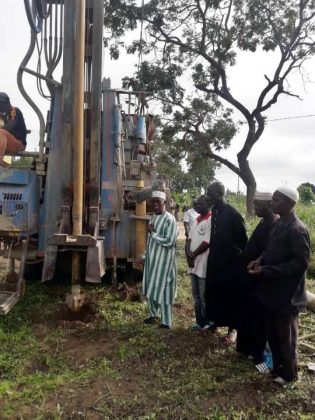 The percentage of the total population in the Tchaoudjo District with access to potable water is estimated to be 35 percent. In the Centrale region, only 41% of the population are estimated to have access to potable water hence the need is immense. The current water assistance program in Togo chooses to focus on village-level health care clinics with the intention of addressing both a health care need and to provide potable water to the surrounding neighborhoods during months of water scarcity.
The percentage of the total population in the Tchaoudjo District with access to potable water is estimated to be 35 percent. In the Centrale region, only 41% of the population are estimated to have access to potable water hence the need is immense. The current water assistance program in Togo chooses to focus on village-level health care clinics with the intention of addressing both a health care need and to provide potable water to the surrounding neighborhoods during months of water scarcity.
The maternity delivery room was equipped with a sink, faucet and running, potable water, and through additional outside funding; a floor drain and a discharge chamber, both plumbed to a dedicated subsurface cement-lined and ventilated septic tank. Delivery room waste (blood and tissue) can now be dispensed with directly in the maternity room in a safe and hygienic manner, rather than hand-carried by the midwives to an outdoor pit or in many cases poured into the latrines.
The Togolese Ministry of Health’s regional office compiled a list of community health clinics in critical need of water for each of the four districts within the Central Region. These community health clinics are run by the Ministry of Health and are the first rung of health care services designed for rural communities, known locally as a Unité Soins Périphérique or “USP” (hereafter refers to as “ health clinic”) typically staffed with a salaried licensed nurse and midwife. Other personnel at the clinic often include a midwife assistant, a “pharmacist” i.e. someone who dispenses medicines with the supervision of the head nurse, and a community member trained in basic accounting skills to manage the clinic account. The clinic typically cares for range of illnesses, most prominently malaria, gastro-intestinal and respiratory ailments, and surficial infections. However, providing women with maternity care, pre and post-birth, was the primary reason for their establishment several decades ago and has since been the main emphasis of these rural clinics.
The scope of the current Water Charity assistance program managed by the in-country coordinator is to meet this water scarcity by installing deep borehole wells and a water distribution system to provide yearlong, potable water to both the clinic and the surrounding community. By maintaining appropriate hygiene in the clinic facilitated by indoor plumbing and uncontaminated water, the presence of pathogens should be reduced. Indoor plumbing will also alleviate the burden on both the clinic staff in general, and the midwives who typically operate under severe and very unhygienic conditions.
Additionally, the added burden imposed on the female relatives of expectant mothers to fetch water from the open, unpotable clinic well (during the rainy season) or further to distant sources during the dry season will be eliminated. The health clinic borehole well program uses the term “borehole” to refer to the mechanical insertion of a vertical pipe (or casing) with a modern, mechanized drilling rig, to depths typically between 60 and 10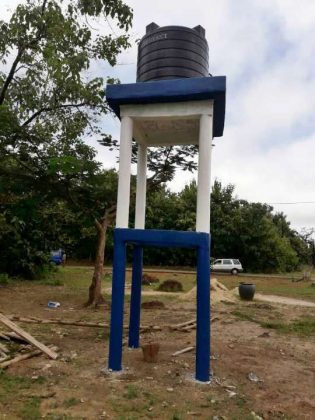 0 meters to reach water-filled fractures, and not a hand-drilled borehole used in some countries with shallower depth to the water table.
0 meters to reach water-filled fractures, and not a hand-drilled borehole used in some countries with shallower depth to the water table.
<p”>Initial site assessment of a designated health clinic (including Sabaringade) was carried out by the Department of Hydraulics hydrologist and the Water Charity coordinator where the following information was collected to determine the feasibility of a borehole well distribution system, in consultation with both clinic staff and community leaders:
– Date of construction of the clinic and by whom.
– Assessment of the water system currently at site, date of installation and by whom, maintenance history if any, and subsequent modifications to the original system.
– The current power source (solar, electricity, generator).
– Staff positions and numbers are funded by the community.
– Assessment of clinic infrastructure (building, indoor/outdoor plumbing, septic, presence and or condition of latrines)
– Frequency of patients and type of illnesses treated, number of births per month, community training (for example family planning, STD, HIV, maternal-child nutrition)
– Community oversight by leaders – community development organization, village heads and religious leaders (Imams).
– Financial soundness of the clinic insofar as the ability to provide maintenance and upkeep and to pay for fuel to run the generator for those clinics without power, or for the later, to make a regular payment to prevent disruptions of service.
All of the health clinics visited were in critical need of water however given the limitations in funding, the final determination of a project site was based on several factors including the motivation of the clinic staff to responsibly manage the borehole well water system to ensure future repairs; the community leaders to contribute building material and labor during well implementation; the presence of an established water committee to manage community access to the well during months of water scarcity; viability of the clinic itself i.e. frequency of clinic visits; and financial means (and willingness) to create a separate well repair account.
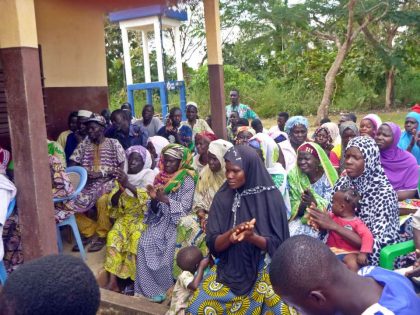 Sabaringade met the project criteria discussed above, particularly given the water shortages in the neighborhoods surrounding the health clinic. The purpose of the borehole well project at the Sabaringade health clinic was to address both a shortage of year-round water and unpotable water at the clinic, to provide running water to the clinic, and to make water available to the community on an as specified basis during times of scarcity. The scope of the borehole project entailed drilling a 60-meter borehole well, properly “developed” using modern technology and equipment; equipping the borehole with an electric submersible pump, constructing a 4.5-meter-high cement block water tower topped with a 2,000-liter polyethylene water tank, installing a gas-powered generator as no electric power is available in the village, outdoor water access points (faucets next to the clinic), a water access point on the water tower for community members, and the servicing of the well to the indoor plumbing.
Sabaringade met the project criteria discussed above, particularly given the water shortages in the neighborhoods surrounding the health clinic. The purpose of the borehole well project at the Sabaringade health clinic was to address both a shortage of year-round water and unpotable water at the clinic, to provide running water to the clinic, and to make water available to the community on an as specified basis during times of scarcity. The scope of the borehole project entailed drilling a 60-meter borehole well, properly “developed” using modern technology and equipment; equipping the borehole with an electric submersible pump, constructing a 4.5-meter-high cement block water tower topped with a 2,000-liter polyethylene water tank, installing a gas-powered generator as no electric power is available in the village, outdoor water access points (faucets next to the clinic), a water access point on the water tower for community members, and the servicing of the well to the indoor plumbing.
WORK ACCOMPLISHED (progression of work through each stage)
1) Site assessment of the existing water system. Community meetings with village leaders, community development members, and the health clinic staff to discuss feasibility of project relative to the community contribution (labor, housing for drill crew and building material for the cement water tower. In addition, the financial strength of the clinic budget was assessed and the motivation of the clinic staff to maintain the well system in constant working order. Discussed the ability of the clinic staff to repair/replace indoor plumbing necessary as the project limits its scope to borehole well, water tower, power source and plumbing for both outside and indoor access. The clinic was notified of its responsibility to repair or replace plumbing and hardware as needed as the center was plumbed originally for running water.
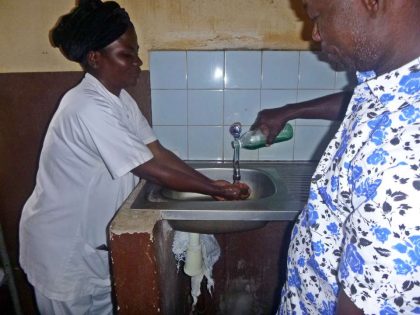 2)The geophysical field study lead by a Togolese firm (overseen by the drilling contractor) was implemented to determine borehole drill placement using the electric resistivity method to locate deep-seated water-filled fractures (or fissures). Knowledge of prior hydrogeological investigations Borehole placement was identified based on geophysical indicators of a fracture-filled water aquifer (defined as a “saturated permeable geologic unit that can transmit significant quantities of water under ordinary hydraulic gradients” [Freeze and Cherry, 1979. Groundwater p.47].
2)The geophysical field study lead by a Togolese firm (overseen by the drilling contractor) was implemented to determine borehole drill placement using the electric resistivity method to locate deep-seated water-filled fractures (or fissures). Knowledge of prior hydrogeological investigations Borehole placement was identified based on geophysical indicators of a fracture-filled water aquifer (defined as a “saturated permeable geologic unit that can transmit significant quantities of water under ordinary hydraulic gradients” [Freeze and Cherry, 1979. Groundwater p.47].
3) A local Togolese drilling company based in Tchamba with extensive experience was hired to oversee the borehole well water system for the Sabaringade health clinic. The Department of Hydraulics Director prepared a contract stipulating the conditions, responsibilities, and timelines for the project. A borehole drilling machine was brought to the clinic and the borehole site was prepared for drilling. The community provided a secure building for equipment storage and housing for the drill crew. A borehole well was drilled using an industry-standard rotary drilling machine attached to a flatbed truck which accomplishes two tasks; using rotation, a drill bit cuts away at the bedrock while PVC drill pipes are lowered progressively into the drilled or vertical “borehole”, in this case using compressed air. The well was drilled to a depth of 60 meters, through the lateritic overburden into the crystalline bedrock. Material brought to the surface during drilling was identified to assist the driller and hydrogeologist in classifying the geologic formations within the borehole (figure 1). The geophysical study also helped to identify shallower, less desirable groundwater intrusions which were sealed from entering the borehole. The aquifer tapped by the borehole water is a confined aquifer ( where there an impermeable layer above the aquifer thereby allowing groundwater in a borehole well to rise above the aquifer). The static water table (the water table before pumping) was at 8 meters, while the dynamic water table ( the water table during pumping at the desired yield)was 17 meters below the ground surface. The well was screened between 51 and 48 meters (slits in the well casing) thus allowing groundwater to enter the borehole.
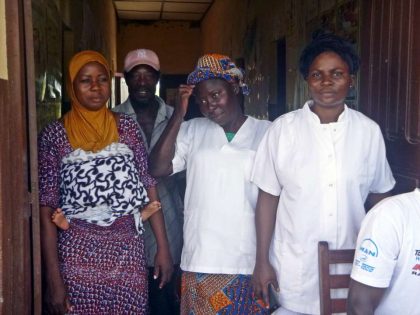 4) An electric submersible pump was inserted at 30 meters and a pump test was initiated to determine the well’s productivity. Essentially the pump is run for several hours at a rate like actual pumpage use, the declining water table is measured at regular intervals and the return flow to the initial measured water table provides information on the transmissivity of groundwater through the subsurface material i.e. how rapidly the well recovers from pumping. Once a well is free of any accumulated fines, it can be properly evaluated for water it will yield. The Sabaringade borehole was drilled to a depth of 60 meters has a yield of 4,500 liters/hour which is more than adequate to supply not only the clinic and the surrounding households. The pump test also indicates a rapid filling of the borehole after pump use. Simply put, the hydraulic conditions of the well are favorable to insure a sustainable water supply.
4) An electric submersible pump was inserted at 30 meters and a pump test was initiated to determine the well’s productivity. Essentially the pump is run for several hours at a rate like actual pumpage use, the declining water table is measured at regular intervals and the return flow to the initial measured water table provides information on the transmissivity of groundwater through the subsurface material i.e. how rapidly the well recovers from pumping. Once a well is free of any accumulated fines, it can be properly evaluated for water it will yield. The Sabaringade borehole was drilled to a depth of 60 meters has a yield of 4,500 liters/hour which is more than adequate to supply not only the clinic and the surrounding households. The pump test also indicates a rapid filling of the borehole after pump use. Simply put, the hydraulic conditions of the well are favorable to insure a sustainable water supply.
5) A water sample from the Sabaringade borehole well was taken and sent to the Regional laboratory in Sokodé, the regional capital, for a complete microbial and inorganic compound analysis. The results of this analysis indicate zero presence of any of the disease-causing bacteria tested (E Coli, Salmonella, Fecal Streptococci, Enterococci and a general category of thermotolerant coliforms). Of the inorganic elements tested (elements found in the bedrock, and nitrate, a product of fertilizer use and septic/sewage contamination) all were within acceptable levels. The water quality from deep borehole wells is potable, bacteria-free water with no discernible color, taste or odor. The results from shallow wells tested in the region indicate bacteria counts exceeding 100 counts/ml (the international standard is 0/ ml) thus attesting to the non-potability of these shallow wells whether open or sealed with a hand pump. Lateral subsurface movement of water from contaminated sources outside the immediate well area occur even if hygiene practices around the well are respected, due to polluted streams, septics and latrines, and surface infiltration of contaminants from animal processing and open defecation.
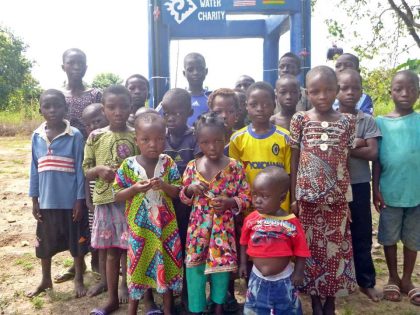 6) Construction of a 4.5-meter-high cement block water tower equipped with a 2,000-liter polyethylene water tank. The community contributed sand, gravel, and labor in manufacturing the cement bricks needed for constructing the water tower.
6) Construction of a 4.5-meter-high cement block water tower equipped with a 2,000-liter polyethylene water tank. The community contributed sand, gravel, and labor in manufacturing the cement bricks needed for constructing the water tower.
7) Piping installed from the borehole well to the water tank and from the tank to both the outdoor faucets and the intake valve to the building allows for a gravity-fed routing of water powered by a gas generator as there is no electricity at the clinic. Additional water spigots were installed at head height on the water tower to allow the community members (women) to fill their basins directly without having to lift heavy basins of water as is the case with hand pumps. The clinic staff replaced worn faucets and indoor plumbing as needed prior to the opening.
8) Numerous visits were made during the well installation by the Coordinator and the government hydrologist to ensure the clinic and community leaders understood the responsibilities associated with maintaining and ensuring a sustainable water supply. A final visit by the Regional Director of hydraulics insured the borehole well and the associated delivery system met all the driller’s contract requirements and functionality.
9) An official technical opening concluded the project with a presentation by the driller on the borehole well components, brief discourses by members of the project team, village leaders, clinic staff, and representatives from the regional ministry of health. Sabaringade was well represented by the religious leaders of the predominantly Muslim community, male and female elders, children, community development members, and some members of the general population. As the representative for Water Charity and its donor(s), when asked to speak to the assembly the coordinator reinforced previously discussed themes of maintenance and upkeep through the active participation of a community water committee and a clinic repair account, and managing public access to the well in a non-disruptive manner to the clinic staff and patients, and most importantly to take ownership of this valuable resource.
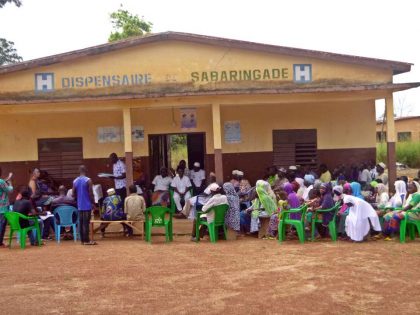 The Department of Hydraulics will assume monitoring of the borehole well from a maintenance perspective for an indefinite period. The Department has on its staff personnel trained to work with community water committees and clinic staff. The contract states a one-year guarantee for the submersible well. Any technical problems that arise with the initial use will be addressed by the drilling company.
The Department of Hydraulics will assume monitoring of the borehole well from a maintenance perspective for an indefinite period. The Department has on its staff personnel trained to work with community water committees and clinic staff. The contract states a one-year guarantee for the submersible well. Any technical problems that arise with the initial use will be addressed by the drilling company.
The clinic staff does not foresee a need for the community to access the well water until later in the year when the local wells begin to dry up. While there has been much discussion around the issue of how the clinic will manage community access to the well, it remains to be seen how this will play out. The well is primarily for the clinic however, in water-scarce communities, water sources are shared. Given the well is powered by a gas generator which the clinic is responsible for running and maintaining in constant working order, the clinic will collect a nominal fee from the users to be deposited in a separate account.
The Sabaringade clinic serves a population of approximately 3,800 people, including the neighboring villages. While clearly not all will be accessing the well water (though there is only one other deep borehole well in the village), an estimated 2,000 people will probably use the well during the dry months ( from February on). The clinic anticipates seeing a rise in births at the clinic now that there is running water and female relatives are no longer obliged to fetch water for the patient – not to mention the overall hygiene. The clinic will use access to potable water to encourage better overall hygiene given most of the disease-causing bacteria in the community water sources are due to fecal transmission by both animals and humans.
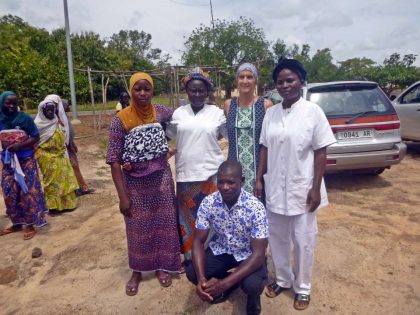 Conclusion
Conclusion
The Regional Director of the Department of Hydraulics stated in his technical report (information provided in this report on borehole characteristics and figure 1) the following: “The political view of the government of Togo states shallow wells on the order of 7 to 25 meters are considered unhygienic and unpotable. The subsurface zone at this depth receives only infiltrated water directly from the surface of water that flows laterally into this zone from contaminated sources (other wells, wastewater, septics, streams). Deep borehole wells reaching uncontaminated water is the only acceptable water for our population.” In this light, the Sabaringade health clinic borehole well water system has fully succeeded in meeting both the local and national objectives for potable water. The community of Sabaringade offers its sincere thanks and gratitude to the donor(s) for this valuable water resource. As they here “ l’eau est la vie” . Water is life, and the cleaner the water the longer and more satisfying than life will be! Un grand merci!